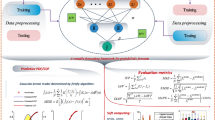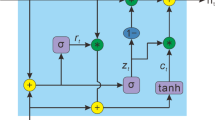Abstract
As a consequence of increasing wind power penetration level, it will be a big challenge to control and operate the power system because of the inherent uncertainty of the wind energy. One of the ways to deal with the wind power variability is to predict it accurately and reliably. The traditional point forecasting-based technique cannot notably solve the uncertainty in power system operation. In order to compute the probabilistic forecasting, which yields information on the uncertainty of wind power, a novel hybrid intelligent method that incorporates the wavelet transform, neural network (NN), and improved krill herd optimization algorithm (IKHOA), is used in this paper. Also, the extreme learning machine is exerted to train NN and calculates point forecasts, and IKHOA is applied to forecast the noise variance. The robust method called bootstrap is regarded to create prediction intervals and calculate the model uncertainty. The efficiency of proposed forecasting engine is evaluated by usage of wind power data from the Alberta, Canada.






Similar content being viewed by others
Abbreviations
- \(b_{i} ,b^{^\circ }\) :
-
Biases of ELM and approximated models
- B PI :
-
Number of the bootstrap duplicates
- ϑ (α) :
-
Indicator of PICP
- LS :
-
Cost function of the gradient-based learning algorithm
- \(DS_{{s^{2} }}\) :
-
Generated dataset for training the models of noise variance estimation
- f D ():
-
Output function
- φ():
-
Activation function of neural network
- H :
-
Hidden-layer output matrix
- \(H^{\dag }\) :
-
Moore–Penrose generalized inverse of the hidden-layer output matrix
- D :
-
Number of hidden nodes
- \({\mathcal{L}}_{t}^{\alpha }\) :
-
Lower bound of PI
- \({\mathcal{U}}_{t}^{\alpha }\) :
-
Upper bound of PI
- m :
-
Dimension of the output vector
- n :
-
Dimension of the input vector
- N :
-
Number of training samples
- \(N_{{\mathcal{T}}}\) :
-
Number of test samples
- IS α t (x i ):
-
Interval score
- \(T, t\) :
-
Matrix of targets, targets/length of time series, time period
- v :
-
Input weights of ELM
- v ♢ :
-
Approximated input weights
- z :
-
Input variables
- L :
-
True regression
- \(\hat{L}\) :
-
Trained neural network
- ∂1−α/2 :
-
Critical value of the normal distribution
- (1 − α):
-
Confidence level
- γ ♢ :
-
Approximated output weights
- γ :
-
Output weights of ELM
- \(\hat{\sigma }_{t}^{2}\) :
-
Variance of the total forecasting error
- \(\hat{\sigma }_{L}^{2}\) :
-
Variance of the model uncertainty
- \(\hat{\sigma }_{\varepsilon }^{2}\) :
-
Variance of the data noise
- ρ α t :
-
Width of PI
- \({\text{M}}\) :
-
Selected wavelet function
- w t :
-
The value of the wind at hour t
- DP M rc :
-
Decomposition coefficient at resolution level r and position c
- A r :
-
Approximation series
- D r :
-
Detail series
- \({\mathcal{M}}\) :
-
Mother wavelet functions
- \({\mathcal{F}}\) :
-
Father wavelet functions
- \({\mathcal{X}},{\mathcal{X}}^{best}\) :
-
Position of ith krill individual, position of best krill individual
- \(A_{i} ,A_{w} , A_{b}\) :
-
Fitness value of ith, worth, best individual
- A b i :
-
Best fitness value of the previously visited position associated with ith krill individual
- \({\mathcal{X}}_{i}^{b}\) :
-
Previous best position of the ith krill individual
- ac s :
-
Accumulation factor of sth strategy
- C d :
-
Cartesian distance to best krill individual
- iter :
-
Iteration counter
- iter max :
-
Maximum number of iterations
- \({\mathcal{X}}^{M}\) :
-
New improved individual based on the mutation operator
- \({\mathcal{X}}_{{TS_{i} }}\) :
-
ith test individual produced in each strategy
- N n :
-
Number of neighbors
- N pop :
-
Krill size
- N d :
-
Number of the decision variables
- N im :
-
Number of krill individuals which choose a strategy
- Pr s :
-
Normalized probability associated with sth strategy
- \(d_{z}\) :
-
Diagnosing zone
- UP j :
-
Upper restriction of jth decision variable
- LOW j :
-
Lower restriction of jth decision variable
- \({\mathcal{V}}_{I,i}^{g}\) :
-
Induced velocity in gth generation
- \({\mathcal{V}}_{F,i}^{g}\) :
-
Foraging velocity in gth generation
- \({\mathcal{V}}_{D,i}^{g}\) :
-
Diffusion velocity in gth generation
- \({\mathcal{V}}_{I,i}^{max}\) :
-
Maximum induced velocity
- \({\mathcal{V}}_{i}^{g}\) :
-
Speed of ith krill individual
- ℓ i :
-
Random variable
- \(\partial_{I} , \partial_{F}\) :
-
Inertia weight of induction velocity, inertia weight of foraging velocity
- \(\text{g}_{m}\) :
-
Mutation level
- g :
-
Generation index
References
Bhaskar K, Singh S (2012) AWNN-assisted wind power forecasting using feed-forward neural network. IEEE Trans Sustain Energy 3:306–315
Costa A, Crespo A, Navarro J, Lizcano G, Madsen H, Feitosa E (2008) A review on the young history of the wind power short-term prediction. Renew Sustain Energy Rev 12:1725–1744
Lei M, Shiyan L, Chuanwen J, Hongling L, Yan Z (2009) A review on the forecasting of wind speed and generated power. Renew Sustain Energy Rev 13:915–920
Potter CW, Negnevitsky M (2006) Very short-term wind forecasting for Tasmanian power generation. IEEE Trans Power Syst 21:965–972
Yang M, Fan S, Lee W-J (2013) Probabilistic short-term wind power forecast using componential sparse Bayesian learning. IEEE Trans Ind Appl 49:2783–2792
Dowell J, Pinson P (2016) Very-short-term probabilistic wind power forecasts by sparse vector autoregression. IEEE Trans Smart Grid 7(2):763–770
Yan J, Li K, Bai E-W, Deng J, Foley AM (2016) Hybrid probabilistic wind power forecasting using temporally local Gaussian process. IEEE Trans Sustain Energy 7:87–95
Yang M, Lin Y, Han X (2016) Probabilistic wind generation forecast based on sparse Bayesian classification and Dempster-Shafer theory. IEEE Trans Ind Appl 52:1998–2005
Haque AU, Nehrir MH, Mandal P (2014) A hybrid intelligent model for deterministic and quantile regression approach for probabilistic wind power forecasting. IEEE Trans Power Syst 29:1663–1672
Kavousi-Fard A, Khosravi A, Nahavandi S (2016) A new fuzzy-based combined prediction interval for wind power forecasting. IEEE Trans Power Syst 31:18–26
Bessa RJ, Miranda V, Botterud A, Wang J, Constantinescu M (2012) Time adaptive conditional kernel density estimation for wind power forecasting. IEEE Trans Sustain Energy 3:660–669
Bessa RJ, Miranda V, Botterud A, Zhou Z, Wang J (2012) Time-adaptive quantile-copula for wind power probabilistic forecasting. Renew Energy 40:29–39
Zhang Y, Wang J (2016) K-nearest neighbors and kernel density estimator for GEFCom2014 probabilistic wind power forecasting. Int J Forecast 32(3):1074–1080
Pinson P, Kariniotakis G (2010) Conditional prediction intervals of wind power generation. IEEE Trans Power Syst 25:1845–1856
Quan H, Srinivasan D, Khosravi A (2014) Short-term load and wind power forecasting using neural network-based prediction intervals. IEEE Trans Neural Netw Learn Syst 25:303–315
da Silva APA, Moulin LS (2000) Confidence intervals for neural network based short-term load forecasting. IEEE Trans Power Syst 15:1191–1196
Bhaskar K, Singh S (2012) AWNN-assisted wind power forecasting using feed-forward neural network. IEEE Trans Sustain Energy 3:306–315
Wan C, Xu Z, Pinson P, Dong ZY, Wong KP (2014) Probabilistic forecasting of wind power generation using extreme learning machine. IEEE Trans Power Syst 29:1033–1044
Huang G-B, Zhu Q-Y, Siew C-K (2004) Extreme learning machine: a new learning scheme of feedforward neural networks. In: 2004 IEEE international joint conference on neural networks, 2004. Proceedings, pp 985–990
Huang G-B, Zhu Q-Y, Siew C-K (2006) Extreme learning machine: theory and applications. Neurocomputing 70:489–501
Shrivastava NA, Panigrahi BK (2014) A hybrid wavelet-ELM based short term price forecasting for electricity markets. Int J Electr Power Energy Syst 55:41–50
Conejo AJ, Plazas M, Espinola R, Molina AB (2005) Day-ahead electricity price forecasting using the wavelet transform and ARIMA models. IEEE Trans Power Syst 20:1035–1042
Zhao JH, Dong ZY, Xu Z, Wong KP (2008) A statistical approach for interval forecasting of the electricity price. IEEE Trans Power Syst 23:267–276
Winkler RL (1972) A decision-theoretic approach to interval estimation. J Am Stat Assoc 67:187–191
Efron B, Tibshirani R (1993) An introduction to the bootstrap. CRC, Boca Raton
Gandomi AH, Alavi AH (2012) Krill Herd: a new bio-inspired optimization algorithm. Commun Nonlinear Sci Numer Simul 17:4831–4845
Sideratos G, Hatziargyriou N (2007) Using radial basis neural networks to estimate wind power production. In Power Engineering Society General Meeting, 2007. IEEE, pp 1–7
Alberta Electric System Operator. https://www.aeso.ca
Kwiatkowski D, Phillips PC, Schmidt P, Shin Y (1992) Testing the null hypothesis of stationarity against the alternative of a unit root: how sure are we that economic time series have a unit root? J Econom 54:159–178
Rafiei M, Niknam T, Khooban MH (2016) Probabilistic electricity price forecasting by improved clonal selection algorithm and wavelet preprocessing. Neural Comput Appl 16:1–3
Rafiei M, Niknam T, Khooban MH (2016) A novel intelligent strategy for probabilistic electricity price forecasting: wavelet neural network based modified dolphin optimization algorithm. J Intell Fuzzy Syst 31(1):301–312
Rafiei M, Niknam T, Khooban MH (2016) Probabilistic forecasting of hourly electricity price by generalization of ELM for usage in improved wavelet neural network. IEEE Trans Ind Inform PP(99):1. doi:10.1109/TII.2016.2585378
Author information
Authors and Affiliations
Corresponding author
Rights and permissions
About this article
Cite this article
Afshari-Igder, M., Niknam, T. & Khooban, MH. Probabilistic wind power forecasting using a novel hybrid intelligent method. Neural Comput & Applic 30, 473–485 (2018). https://doi.org/10.1007/s00521-016-2703-z
Received:
Accepted:
Published:
Issue Date:
DOI: https://doi.org/10.1007/s00521-016-2703-z




